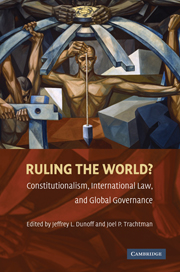Book contents
- Frontmatter
- Contents
- Contributors
- Preface: International Institutions: Why Constitutionalize?
- Acknowledgments
- PART I WHAT IS CONSTITUTIONALIZATION BEYOND THE STATE?
- PART II THE CONSTITUTIONAL DIMENSIONS OF SPECIFIC INTERNATIONAL REGIMES
- PART III CROSSCUTTING ISSUES
- 9 Human Rights and International Constitutionalism
- 10 The Cosmopolitan Turn in Constitutionalism: On the Relationship between Constitutionalism in and beyond the State
- 11 Constitutional Heterarchy: The Centrality of Conflict in the European Union and the United States
- 12 Courts and Pluralism: Essay on a Theory of Judicial Adjudication in the Context of Legal and Constitutional Pluralism
- 13 Whose Constitution(s)? International Law, Constitutionalism, and Democracy
- Index
- References
9 - Human Rights and International Constitutionalism
Published online by Cambridge University Press: 05 June 2012
- Frontmatter
- Contents
- Contributors
- Preface: International Institutions: Why Constitutionalize?
- Acknowledgments
- PART I WHAT IS CONSTITUTIONALIZATION BEYOND THE STATE?
- PART II THE CONSTITUTIONAL DIMENSIONS OF SPECIFIC INTERNATIONAL REGIMES
- PART III CROSSCUTTING ISSUES
- 9 Human Rights and International Constitutionalism
- 10 The Cosmopolitan Turn in Constitutionalism: On the Relationship between Constitutionalism in and beyond the State
- 11 Constitutional Heterarchy: The Centrality of Conflict in the European Union and the United States
- 12 Courts and Pluralism: Essay on a Theory of Judicial Adjudication in the Context of Legal and Constitutional Pluralism
- 13 Whose Constitution(s)? International Law, Constitutionalism, and Democracy
- Index
- References
Summary
Introduction
Gerald Neuman starts an important essay as follows: “Two leading systems exist today for protecting the fundamental rights of individuals: constitutional law and [international] human rights law.…For liberal states that actively enforce constitutional norms, the relationship between these two systems assumes increasing importance.” Neuman explores this relationship by focusing on the institutional consequences and mutual interactions of the two systems.
In trying to both clarify and evaluate the role of human rights law in discussions about international constitutionalism, my focus in this chapter will be less on the relationship between these two legal systems than on their differences and respective functions. I will ask and address two threshold questions. First, how different are the two systems? Second, why have both systems?
Whatever the general degree of analogy or dissimilarity between constitutional law and international law, domestic bills of rights and international human rights law undoubtedly perform the same basic function of stating limits on what governments may do to people within their jurisdictions. Indeed, in “liberal states that actively enforce constitutional norms,” international human rights law tends to place similar limits on the very same governments. So what are the major differences between the two beyond the obvious one of source? In particular, is there anything “constitutional” about international human rights law? Should one conclude from the similarity of function and substance that international human rights law is primarily meaningful in, or addressed to, nonliberal or non-Western states?
- Type
- Chapter
- Information
- Ruling the World?Constitutionalism, International Law, and Global Governance, pp. 233 - 257Publisher: Cambridge University PressPrint publication year: 2009
References
- 19
- Cited by

